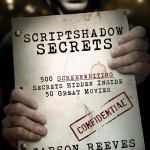
It doesn’t get much better than Goodfellas, a script based on the non-fiction book “Wiseguy” by Nicholas Pileggi (who shares writing credit with Martin Scorsese on the film). The film came out in 1990 and got nominated for six Academy Awards. Joe Pesci, in a role he’s still getting mileage out of, won for best supporting actor. While the story structure was put in place by the writers, much of the great dialogue was discovered through rehearsals, where Scorsese let his actors roam free, then wrote into the script many of the lines they came up with. While Pileggi wanted to follow a traditional narrative, Scorcese didn’t think it was necessary, believing the film was more a combination of episodes, and those episodes could be told out of order. It’s this and a few other non-traditional choices that make Goodfellas so interesting to study as a screenplay. As the story goes, after reading the book, which Scorsese thought was the best book on the mob ever written, he called Pileggi and said, “I’ve been waiting to direct this book my whole life,” to which Pileggi responded, “I’ve been waiting for this phone call my whole life.”
1) The tragedy script – The tragedy script does not follow the traditional three-act structure (setup, conflict, resolution). It works more in two halves. You build up the hero’s success in the first half, then have them fall apart in the second. That second half fall should be dictated by the hero’s flaw, which can be anything, but is most often greed.
2) The cool thing about tragedies is that you can have your main character do some pretty horrible things – The audience understands this isn’t a romantic comedy. They don’t need their main character to be a saint. They get that bad things are going to happen and that our protagonist is going to be unsavory. Embrace that. I mean, despite all of us falling in love with Henry’s (Ray Liotta) first love, Karen, he starts having an affair with another woman on the side. You can’t do that in a traditional film without the audience turning on the protag. The one caveat to all of this, is that we must START OUT loving our main character. We’ll only go down the dark path with him if we liked him before he got there. So it’s no coincidence that Scorsese and Pileggi used one of the most common tools available to make us fall in love with Henry – they made him an underdog – the little nobody kid from the streets who worked his way up the system.
3) Give ’em something to talk about – What I learned about voice over during Goodfellas (which is used practically non-stop) is that if you have a fascinating subject matter and you’ve researched the hell out of it, the device is a great way to give us all of that information. What sets movies like Goodfellas and, say, Casino apart is those “behind the curtain” details we learn about the subject matter. You walk away knowing exactly what it was like to be a wiseguy (or what it was like working in a Casino) after watching these films. But extensive voice over like this ONLY WORKS if the subject matter is fascinating, if you’ve researched the shit out of it, and if you’re telling us stuff we don’t already know. Break one of those three rules, and the voice over will probably get tiresome.
4) We’re more likely to go along with a character’s suspect choices if we’re inside his head (listening to his voice over) – There’s something about hearing a character’s play-by-play of his life that makes us more tolerant of the terrible things he does. If Henry is robbing people and cheating on people and killing people without him ever telling us why, there’s a good chance we’ll turn on the character. But because he’s explaining it to us as he goes along via voice over, we understand his choices. It’s kind of like hearing that some random person you don’t know is cheating on their spouse. You immediately conclude that they’re a terrible person. But when your best friend cheats on their spouse, and they explain to you why they’re doing it and what went into the choice, you’re more okay with it. Voice-over can be very powerful that way.
5) Research research research – I’ve read a LOT of amateur scripts about the mob over the years and none of them ever come close to Scorsese’s films. Why? Research. Nothing feels original or unique. These writers fail to understand that Scorcese is using material that has been meticulously researched. I mean, authors like Pileggi have spent hundreds of hours talking to the REAL PEOPLE involved in these crime magnets. He’s getting the stories that REALLY happened. Whereas with amateurs, they’re making up stories based on their favorite movies. Therefore they read like badly made copies. So if you’re going to jump into this space, you better have at least a hundred hours of research to base your story on. Or else forget about it.
6) Start your script with a bang – Goodfellas starts with a bang and never lets go. And that got me thinking. In the comments section of the Amateur Offerings post this weekend, a commenter said he stopped reading one of the entries after page one because it was boring. A debate then began on whether the first page of a script should always be exciting. Some believed it should, and others said the writer should be afforded more time. The actual answer to this question is complicated. In the spec world, yes, the first page should immediately grab the reader. However, your first scene should also be dictated by the genre and story. If you’re telling a slow-burn story, for example, then a slower opening makes sense. But the definitive answer probably lies within what happens BEFORE you write the first page. You should choose the type of story that would have an exciting opening page in the first place, since it IS so important to grab that reader from page one. Once you’re established and people will read your scripts no matter what, THEN you can afford to take your time getting into your story.
7) Always look to complicate your scenes – Driving a dead guy into the woods to bury him isn’t a very interesting scene. Driving a “dead guy” who all of a sudden starts banging on the inside of the trunk (Oh no, he’s still alive), is. And it leads to one of the most memorable moments in Goodfellas, when Tommy starts bashing the still-moving bloody mattress cover over and over again. Try not to allow your scenes to move along too smoothly. Always complicate them somehow. It usually results in something more interesting.
8) Beware the mob/gangster screenplay naming conundrum – One of the biggest assumptions young writers make is that readers will remember however many characters they introduce, be it 5 or 500. I can’t stress enough that too many characters leads to character mix-up which leads to story confusion. Mob movies are particularly susceptible to this problem for two reasons. One, they naturally have a lot of characters. And two, most of the character names sound the same, ending in “-y” or “-ie” (Jonny, Billy, Tommy, Frankie) making it particularly easy to mix characters up. For this reason, whenever you write one of these scripts, it is essential that you make everybody memorable and distinctive. Here are a few tips to achieve this (note that these will work for any script with a lot of characters):
a. Only create characters if they’re absolutely essential to the story (less characters equals less of a chance the reader will forget who’s who).
b. Differentiate names as much as possible (don’t use “-y” and “-ie” names if you can avoid it). If you have to do this, consider using a nickname or their last name to identify them by.
c. Describe each character succinctly. No bare-bones “fat and awkward” descriptions.
d. Give each character their own unique quirks. Anything to make them stand out from the other characters.
e. Open up with a memorable character-specific scene for each of your big characters. So if you have a character who has a temper, open up with a unique compelling introductory scene that shows him losing his temper (like how we introduce Tommy in Goodfellas, who gets so mad at Billy for insulting him that he kills him).
9) Bounce around a large location easily by using mini-slugs – A mini-slug is basically a quick identifier of where we are inside a larger location. Since a full slug line indicates a more severe location change, it can ruin the flow of a scene if used often. For example, say two characters are bouncing around multiple rooms in a house. You don’t have to write, “INT. KITCHEN – SECOND FLOOR – DAY” every time you come back to the kitchen. Just say, in capital letters, and on their own line: “THE KITCHEN” or “THE BASEMENT” or “THE LIVING ROOM” or wherever the sub-location might be. These are mini-slugs.
10) The “powder keg” character – To me, these characters always work. If you write a slightly crazy character who could blow up at any second, then any scene you put them is instantly tension-filled. It’s like the character brings with him a floor full of pins and needles wherever he goes. It’s why Tommy DeVito (Joe Pesci) is such a classic character. We’re terrified of what he’s capable of. We’re worried that anyone at any moment could say the wrong thing and BOOM! – our powder keg blows up. If you can find a way to weave a powder keg character into your script (and it fits the story), do it. These characters always bring the goods.
 These are 10 tips from the movie “Goodfellas.” To get 500 more of the most helpful screenwriting tips you’ll ever find, mined from movies as varied as “Aliens,” “Pulp Fiction,” and “The Hangover,” check out my book, Scriptshadow Secrets, on Amazon!
These are 10 tips from the movie “Goodfellas.” To get 500 more of the most helpful screenwriting tips you’ll ever find, mined from movies as varied as “Aliens,” “Pulp Fiction,” and “The Hangover,” check out my book, Scriptshadow Secrets, on Amazon!

